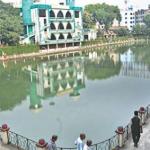Table of contents [Show]
- Introduction to Karnaphuli Tunnel:
- A Pioneering Undertaking
- Engineering Excellence and Innovation at Karnaphuli Tunnel
- Socioeconomic Impact
- Connectivity and Regional Integration
- National Pride and Remembrance about Tunnel
- Crossing Boundaries and Fostering Cooperation
- A Vision for the Future with Karnaphuli Tunnel
Introduction to Karnaphuli Tunnel:
Bangladesh, a country known for its rich history and vibrant culture, has been making remarkable strides in infrastructure development to foster economic growth and regional connectivity. Among its noteworthy achievements is the Karnaphuli Tunnel, officially known as the Sheikh Mujibur Rahman Tunnel. This engineering marvel, named after the nation's founding father, Sheikh Mujibur Rahman, has not only transformed the region's transportation landscape but also symbolizes the nation's commitment to progress and connectivity.

In the southeastern region of Bangladesh, near the coastal city of Cox's Bazar, a remarkable engineering feat stands as a testament to the nation's commitment to progress, connectivity, and the enduring legacy of its founding father. The Karnaphuli Tunnel, officially known as the Sheikh Mujibur Rahman Tunnel, is not just a transportation marvel; it is a symbol of resilience and ambition. This article explores the significance, engineering excellence, socioeconomic impact, and regional importance of the Karnaphuli Tunnel.
- Introduction to Karnaphuli Tunnel:
- A Pioneering Undertaking
- Engineering Excellence and Innovation at Karnaphuli Tunnel
- Socioeconomic Impact
- Connectivity and Regional Integration
- National Pride and Remembrance about Tunnel
- Crossing Boundaries and Fostering Cooperation
- A Vision for the Future with Karnaphuli Tunnel
A Pioneering Undertaking
The Karnaphuli Tunnel, situated near Cox's Bazar in the southeastern region of Bangladesh, was inaugurated on June 25, 2010. This 3.4-kilometer (2.1-mile) long tunnel spans across the Karnaphuli River, a critical waterway that divides the Chittagong Hill Tracts and the rest of the country. The primary purpose of this monumental undertaking was to enhance connectivity and accessibility to a region that had been historically challenged by geographical isolation.
Engineering Excellence and Innovation at Karnaphuli Tunnel
The construction of the Karnaphuli Tunnel was a formidable engineering challenge, characterized by the need to navigate rugged landscapes and surmount adverse weather conditions. Engineers employed state-of-the-art tunneling techniques and materials to ensure structural integrity and long-term stability. The successful completion of this tunnel serves as a testimony to the resilience and determination of the people involved.

Socioeconomic Impact
The socio-economic impact of the Karnaphuli Tunnel has been profound. This tunnel has revitalized the region, fostering economic growth and development. By reducing travel time and facilitating easier access, it has encouraged tourism in the Cox's Bazar area, renowned for having one of the world's longest natural sea beaches. Additionally, it has improved access to essential resources, contributing to an overall better quality of life for the people residing in the Chittagong Hill Tracts.
Connectivity and Regional Integration
The Karnaphuli Tunnel plays a pivotal role in Bangladesh's strategy to enhance its connectivity, both within the country and across borders. It connects to the N1 Highway, which forms a crucial link between the bustling city of Chattogram and the pristine coastal region of Cox's Bazar, further extending to the Teknaf Peninsula, which shares a border with Myanmar. This improved connectivity not only benefits local communities but also has a broader regional significance, promoting trade and cooperation.
National Pride and Remembrance about Tunnel
The tunnel is a symbol of national pride and a tribute to Sheikh Mujibur Rahman, who was not only a key figure in the country's struggle for independence from Pakistan but also served as its first Prime Minister and President. It serves as a reminder of the sacrifices made by the people of Bangladesh to achieve their sovereignty and a testament to the nation's unwavering commitment to progress and development.

Crossing Boundaries and Fostering Cooperation
Beyond its domestic significance, the Karnaphuli Tunnel also underscores the broader theme of regional cooperation. Bangladesh's strategic location makes it a vital connector between South and Southeast Asia. The tunnel enhances not only national connectivity but also regional integration. It offers an efficient route for the transportation of goods from the Bay of Bengal to landlocked countries like Nepal and Bhutan, reducing their dependence on long and often difficult transshipment routes.
The improved access has led to an increase in bilateral and regional trade, strengthening economic ties between Bangladesh and neighboring countries. This has not only stimulated economic growth but also enhanced diplomatic relationships, fostering collaboration and goodwill among nations.
Challenges Overcome
The construction of the Karnaphuli Tunnel was not without its challenges. The rugged terrain, adverse weather conditions, and complex geological features of the Chittagong Hill Tracts posed significant obstacles. Engineers and laborers overcame these challenges through meticulous planning and state-of-the-art technology. The successful completion of this project serves as a testament to the nation's determination and resilience.
A Vision for the Future with Karnaphuli Tunnel
The Karnaphuli Tunnel is just one part of Bangladesh's broader vision for infrastructure development. The country continues to invest in projects aimed at improving transportation, energy, and telecommunications, thus creating an environment conducive to economic growth and regional collaboration.
As Bangladesh strives to transform into a middle-income nation and realize its potential on the global stage, infrastructure projects like the Karnaphuli Tunnel pave the way for a brighter future. They serve as a reminder of the nation's journey from a struggling region to a rising economy, embodying the spirit of unity, progress, and determination that defines Bangladesh.
The Karnaphuli Tunnel is a symbol of Bangladesh's commitment to modernization, economic growth, and regional connectivity. It has bridged geographical gaps, boosted economic development, and opened doors to closer collaboration among nations. As Bangladesh continues to invest in infrastructure projects and propel its transformation into a middle-income nation, the Karnaphuli Tunnel remains a beacon of progress, a testament to the nation's unwavering spirit, and a gateway to a brighter future. It underscores the power of infrastructure projects in reshaping a nation's destiny and creating pathways to prosperity, unity, and connectivity.








